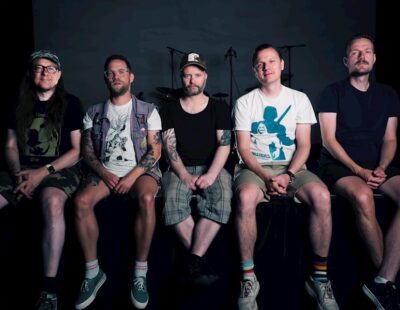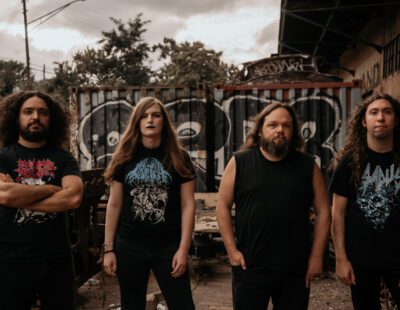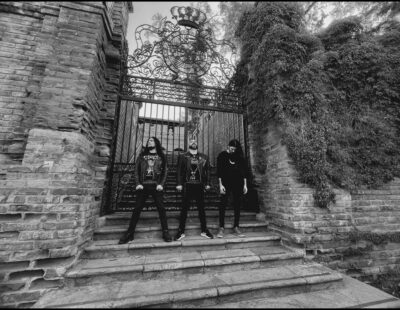** Niklas Sundin and I first interviewed back in ’93 after the release of Skydancer. Well, this year Skydancer, Dark Tranquillity’s stunning debut album, turns 20. To honor how time has been kind to this stellar release, Niklas agreed to answer a few nifty questions. More importantly, Dark Tranquillity have acquired the rights to both Skydancer and its companion EP, Of Chaos and Eternal Night, and are in process of properly reissuing the titles. A remastered Skydancer—different from the Skydancer reissue from 2000—is available for streaming on the group’s Bandcamp site. Click HERE.
20 years?! Where has time gone, Niklas?
Niklas Sundin: You tell me! [Laughs] I seriously have no idea what happened…
You’re celebrating the 20th anniversary of Skydancer by putting out new versions. Tell us about what you’re doing.
Niklas Sundin: Well, it started by accidentally discovering that we had the option of getting back the rights to the Skydancer album and Of Chaos and Eternal Night MCD. None of those albums had been (legally) available digitally for years, and the physical releases were also out of print, so we seized the opportunity to finally get to own our own music. The songs were remastered some weeks ago and are now available in true DIY style on our Bandcamp page (darktranquillity.bandcamp.com). Proper CD/LP versions will follow shortly, and everything should also be available on Spotify, iTunes and so forth before the end of the month.
How does the 20th anniversary edition differ from the re-release in 2000?
Niklas Sundin: The album is properly remastered this time, which wasn’t really the case with the 2000 edition. The production was always the weak point of Skydancer, and while there are limits to what one can do without access to the separate instrument tracks, everything sounds much better now. The album is so old that there wasn’t even any proper mastering done the first time around; all songs had a different output volume and are sonically very incoherent. In addition, the layouts will be different, though I haven’t fully decided what to do yet. Before the Spinefarm deal came along, there were plans of releasing the album through Necropolis Records under the title In the Golden Dawn of Winter, and I made some illustrations for that for that before we decided to use a photographic cover instead. Maybe those will find their way to the re-release. Either way, I want to keep it authentic and have it look like something that actually could have been released back then and not anything modern.
What label is putting out the reissues?
Niklas Sundin: I probably shouldn’t say anything publicly before the deal is signed, but it’s pretty much the label that one would expect.
When we interviewed back in ’93, it was done by mail. I know you’re a proponent of technology, but ever thought about doing one last interview by mail? Hand-written and all.
Niklas Sundin: Nah…there was something very appealing about the process of slowly putting pen to paper to write something and then sending it away to a remote country in an envelope with glued stamps, and in a way I like the fact that it required so much more work and devotion compared to just hitting “send” on the computer, but everything has its time and place. The early tape-trading scene kind of lent itself to that sort of super-analog communication, but it’d be hard to go back from the convenience of e-mail. But I do think that it’s great to see that there are counter movements to the technology boom: Labels releasing music solely on cassettes, bands recording music on 4-track recorders and writers going back to pen and paper in order to make their creative work less of a mechanical process. Too many options and too much comfort can be a bad thing sometimes, and a lot of individuality can get lost when everyone is using the same tools.
Skydancer was a revelation. It sounded so different from everything else at the time. The songs, the vocals, the lyrics, the cover art, the production. What do you remember about putting Skydancer together?
Niklas Sundin: Complete panic! [Laughs] We were well prepared and had rehearsed like madmen, but studio recordings back then were always stressful. Our budget only allowed for ten studio days for recording and mixing, so there wasn’t any time to fine-tune things, and we often had to use first takes even if they weren’t perfect. There was a good idea of we wanted to accomplish, but we lacked the studio knowledge to communicate it to the engineers, who in turn were clueless about extreme metal, so there were lots of tension and misunderstandings. Other than the studio frustration, which I’m sure that anyone recording an underground metal album in the early ’90s can relate to, the whole process was very creative and smooth. There was a real sense of excitement throughout the songwriting process, and it felt like we really were onto something new and original that we needed to capture on tape and let people listen to as soon as possible.
What’s your favorite tune on Skydancer? I think from day one to present, mine’s always been “A Bolt of Blazing Gold.” But I gotta say “Skywards” is creeping in close second.
Niklas Sundin: “Skywards” (listen HERE) should have been my fave pick, and it’s the most technically accomplished song, but the guitars are way too quiet in the mix which always ruined it for me. We somehow moved the guitar channel sliders on the mixing board too low much during the mix-down, and there wasn’t any time to make a new attempt. So, I’d go for the frantic “Nightfall by the Shore of Time” (listen HERE) as my fave. Our only space-themed track, with a title borrowed from the inner sleeve photo of Bathory’s Hammerheart LP.
What were you thinking with the lyrics? I know Sabbat was a personal inspiration, but each song is crammed with words, phrases and pictures. Like “My Faeryland Forgotten” is only 4.5 minutes long but it has 15 pages of lyrics.
Niklas Sundin: Sabbat was the main influence for sure; from Martin Walkyier we got the inspiration to write lengthy and epic lyrics and to feature vocals on almost every riff. Phlegethon from Finland was also a band whose lyrics we approved of. In retrospect, it’s weird how a bunch of kids from suburban Sweden would chose to go for that kind of meticulously crafted verse in archaic English, but both me and Mikael were bookworms back then, and at the time we were fixated on the idea of creating something larger than life—a band that would be a world in itself and represent something bigger than just mere music. It was all very over-the-top, extremely pretentious, and in many ways hard to relate to when being twice as old, but I’m honestly pretty impressed by what we managed to came up with as teenagers. I never could write lyrics with that kind of flow and complexity today.
Do you remember how it was received? Distribution was pretty poor, considering it was one of Spinefarm’s earliest releases.
Niklas Sundin: Yes, Spinefarm was mainly a distribution company back then, and I think that they only had released Beherit’s Drawing Down the Moon and North from Here by Sentenced prior to our album. Nevertheless, Skydancer found its way to a lot of unlikely places. We were avid tape-traders back then and would put the album on Side B on every cassette we sent out, meaning that several hundred people heard it that way and then spread it even further. The response was overwhelmingly good – out of the very many reviews we read, only Close-up magazine from Sweden was negative (much to our disdain, since this was the magazine that everyone knew back home). The first version of our website had an archive with lots of ‘zine reviews for the early albums, but unfortunately those files are long lost. Otherwise it’d be a nice addition to the reissue layout.
Decibel inducted The Gallery into the Hall of Fame back in 2010. Think we made the right choice or should we have gone with Skydancer?
Niklas Sundin: No, The Gallery had more impact, so it was the right choice. Skydancer is more unique, but its weirdness and eccentricity always made it more of an acquired taste rather than a breakthrough release. But there still are a lot of people that consider it to be our best album, just as there are people that prefer At the Gates’ The Red in the Sky is Ours to their later releases. Of course those records are very different from each other, but what they have in common is that they’re wildly experimental debut albums that were followed by more controlled and streamlined records.
Any chance a Skydancer tune could end up in setlists for 2013?
Niklas Sundin: We’ll see. It has to be for the right reasons and we have to be able to do the music justice in a way that the 17-year old us would have approved of. Much of the charm of those songs lies in the fact that we’re playing a bit over our real abilities and that the music sometimes is on the verge of falling apart. Tempos go up and down, and the tremolo picking isn’t always supposed to be very precise or logical, so in a way it’s the opposite of what we’re doing these days. I think that if one looks beyond the nostalgia factor, it doesn’t always work when veteran bands perform their early material live. Everyone is used to the looseness of the original recordings, so a technically improved and tighter live performance can sometimes take away the magic.
** Dark Tranquillity’s Skydancer will be available on CD and LP in the near future on an as-yet-determined record label (prediction: Century Media). Until then you can buy the album for a mere 7E digitally or stream it for free. We hope you pick the former over the latter. Click HERE.





